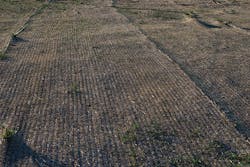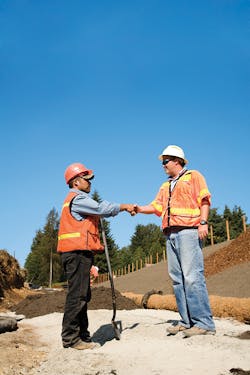One of the key factors on an earthmoving job is not only moving it but controlling it in such a way that it doesn’t erode.
Erosion control is a permanent measure to keep land from eroding due to water or wind. It augments sediment control, a temporary measure to keep dirt on a construction site and from entering places it should not be, such as in a water body or on a road.
“In a perfect world, if we wanted all regulations to be followed, erosion control would be considered during the planning and engineering stages and plans would have erosion Best Management Practices (BMPs) incorporated so that it was built in and erosion addressed before it ever became an issue,” says Chris Rider, chief technical officer, Global Environmental Solutions. The company provides customized erosion and sediment control solutions.
For design-build projects, erosion control measures are considered from the onset of the project, points out Jill Pack, CPESC, spokesperson for North American Green. The company manufactures a line of erosion and sediment control systems to meet specific erosion control, sediment control, hydraulic, scour protection, and/or vegetation reinforcement needs.
“In these cases, erosion and sediment control practices are written into the Stormwater Pollution Prevention Plan (SWPPP), and placed into the project bid. It is common that erosion control and vegetation establishment is phased near the end of the project’s completion, and many times it is bid by a specialized landscape contractor,” notes Pack.
For existing or reworked project sites, erosion and sediment control is considered if a problem occurs on the site or conditions change on site and create a new need for protective measures, Pack adds.
In providing erosion control, contractors have a slate of new technologies on the market from which to choose. The erosion control industry is continually evolving with new technology and techniques, says Pack.
“One of the trends we are seeing right now is a push for extending the performance of vegetated designs and bridging the gap between engineered vegetative systems and the more traditional hard armor approach,” she adds. “Higher strength erosion mats and anchoring systems are an example of this.”
Pure acrylic polymer soil binders are much newer than silt fence and hay bales, says Rider.
“Silt fence and hay bales are reactive,” says Rider. “When humans disturb soil during construction projects, they know that dust and erosion will occur, and the silt fence and hay bales stop it from leaving the site after it is already on the move.
“Acrylic polymer soil binders stop it at the source before it begins moving, thereby rendering silt fence and hay bales as secondary, follow-on containment—something like belt and suspenders.”
Minova is an international manufacturer of powders, resins, and anchoring products for geostabilization contractors, specializing in the production of steel materials such as hollow bar, steel rebar, and micropile products.
The company also offers a bundle of alternatives to steel products including Glass Fiber Reinforced Polymer (GFRP) products. Minova also develops and produces its own grouts and resins that are designed to control a variety of water influx problems and also provide “excellent void-filling properties,” says J.W. Jones, a Minova spokesperson.
Minova has the ability to take a bespoke application or product and redesign it from a molecular or chemical standpoint to meet the specific contractor’s needs, says Jones.
For example, in an application where a contractor is doing geostabilization along a shoreline or fault line, the process is examined to ascertain whether the product reaction time should be slowed down because the ambient temperature is significantly high or sped up because it is low, he adds.
Utilizing BMPs ensures optimal success. While the erosion and sediment control industry has a wide range of product types and categories that can be considered BMPs, North American Green primarily focuses on techniques that utilize a vegetative components for stabilization of soils, Pack points out.
“The techniques can range from hydraulic mulch stabilization, temporary cover with erosion control blankets, geosynthetic reinforced vegetative designs, or a combination of these practices,” she says. “Each project site can hold its own unique challenges, and working with a knowledgeable erosion and sediment control professional is always recommended.”
For best erosion control practices and techniques on a job site, “all disturbed areas are treated with a highly water-resistant soil binding agent such as acrylic polymer, with no vinyl polymers or vinyl components in the binder,” says Rider.
“As new areas are disturbed, they would be treated on an ongoing basis. Areas that are re-disturbed would be likewise retreated,” Rider adds.
Minova offers a process of one-step bolting being propagated in the mining industry, “in that you’re able to drill the hole and pump the resin grout into the hole in a single pass” notes Jones. “You flush the hole out and don’t have to pull the drill rod, allowing the rock bolt to be left in the hole and grouted in place.
“Some soils and strata require that you use a pneumatic flush to get the hole cleared out and some use a water flush, where others use an inexpensive slurry flush and then follow up with a final grouting of the hole with the product,” says Jones. “Best practices are relative to the project and to the application.”
In choosing a product for job site erosion control, the critical factor is the total cost of ownership, including when time comes into play and/or difficult conditions occur, Jones says.
For example, for a California dam project, Minova’s products were used to resist turbidity occurring in holes that were being grouted, thus providing the necessary strength and anchorage.
Most of the company’s products are designed to be able to be set up fast and gain high strengths quickly, says Jones.
No erosion control project is the same and may require a combination of techniques to ensure a complete solution. Challenges can include soil conditions, tight schedules, weather conditions, and location.
One of the biggest challenges in providing effective erosion control measures is their proper installation, Pack points out.
“The main reason—if not the number one reason—for erosion control system failures is in poor installation,” says Pack. “I think some of the issues lie in the misconception that erosion and sediment control isn’t all that important or, as a final phase of a project, the goal becomes just to finish quickly.”
Such attitudes can lead to contractors taking shortcuts, with serious issues occurring down the road, Pack notes.
“On the other hand, when contractors become knowledgeable in system installations, it’s a win on all sides of the project,” she adds.
Rider says terrain and weather are the most significant challenges in providing erosion control on job sites.
“Having acrylic polymer soil binders incorporated into the plans before construction starts allows for contractors to plan and develop timing to work around the weather,” adds Rider. “Acrylic polymer soil binders are fast and easy to apply with surface spray equipment, thus eliminating most terrain related issues.”
Jones cites one particular project in which the contractor had concerns about the service roads around a lake having issues with sliding due to slope erosion. Rainwater and erosion had the potential to cause issues with a standard shotcrete, so the company’s TekCrete Fast was used to significantly increase work productivity in a day.
TekCrete is designed to be used with or without a steel or polymer mesh, although the latter provides additional tensile and flexural strength. TekCrete binds broken strata together for better structural integrity.
Often used in a mine where conventional gunite is used, TekCrete performs best when applied as soon as possible after the strata are exposed. TekCrete Fast has a surface coverage of approximately 8.2 square feet per 60-pound bag at a thickness of 1/2 inch.
The product was installed and cured to 2,500 psi in less than 20 minutes without losing strength and providing optimal adhesion, says Jones, adding that the product allowed the contractor to not worry as much about inclement conditions due to the rapid cure time.







